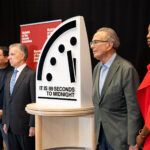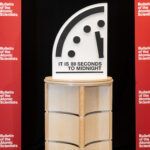UChicago Student Series: The Future of Nuclear Energy in the United States
By Sabrina Fields | April 12, 2021

On Tuesday, March 30, forty graduate students studying policy and business at the University of Chicago attended a virtual event focused on demystifying the state of domestic nuclear energy. The program, “The Future of Nuclear Energy in the United States,” was a joint effort between the Harris School of Public Policy’s Energy and Environmental Association and the Bulletin of the Atomic Scientists and was the first of the 2021 student programs between the Bulletin and the Harris School, where the Bulletin is housed.
The event featured Dr. Ashley Finan, Director of the National Reactor Innovation Center (NRIC) at Idaho National Laboratory in conversation with Sabrina Fields, UChicago Liaison for the Bulletin and first year MPP student at Harris, followed by a Q&A from the student audience. Finan noted that when looking for a source of energy that would produce fewer air pollutants, her upbringing near a nuclear power plant in part inspired her to pursue nuclear engineering.
Nuclear energy accounts for nearly 20% of US electricity, and over 50% of its carbon-free electricity. Yet nuclear power often suffers from efficiency and cost critiques that can only be overcome with modern technology and processes. Enter the National Reactor Innovation Center, charged with accelerating the demonstration of advanced nuclear reactors, and with a vision of at least two by 2025. Finan discussed the importance of public-private partnerships in moving nuclear technology forward, highlighting two projects in particular: the Natrium reactor designed by TerraPower and the Xe-100 reactor designed by X-energy. After successful demonstration, it is NRIC’s hope that reactors like these will be picked up by utility companies and put into operation, providing more generating capacity for clean energy.
With 2025 on the horizon, it is not yet certain what procurement or market incentives might be in place to drive deployment at scale and nth of a kind costs, those some of these exist now, Finan explained. To enable review of innovative designs, the Nuclear Regulatory Commission (NRC) is modernizing its approach, particularly to develop a more technology-inclusive methodology for the wide variety of designs moving towards demonstration. Nuclear power also faces an added barrier of public perception following a history of classified weapons programs and catastrophic nuclear incidents, but Finan affirmed she is hopeful about our ability to overcome these challenges. The primary antidote to these fears, she contends, is transparency and engaged communication.
Together, we make the world safer.
The Bulletin elevates expert voices above the noise. But as an independent nonprofit organization, our operations depend on the support of readers like you. Help us continue to deliver quality journalism that holds leaders accountable. Your support of our work at any level is important. In return, we promise our coverage will be understandable, influential, vigilant, solution-oriented, and fair-minded. Together we can make a difference.
Keywords: nuclear energy, nuclear power
Topics: What’s New at the Bulletin















